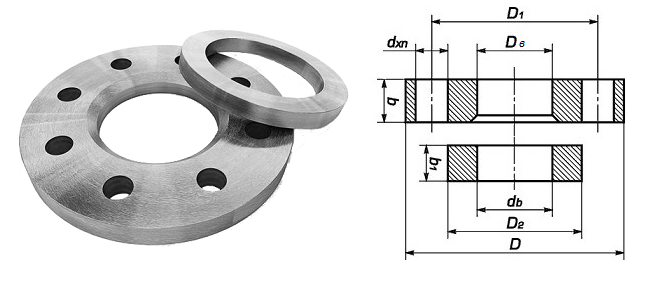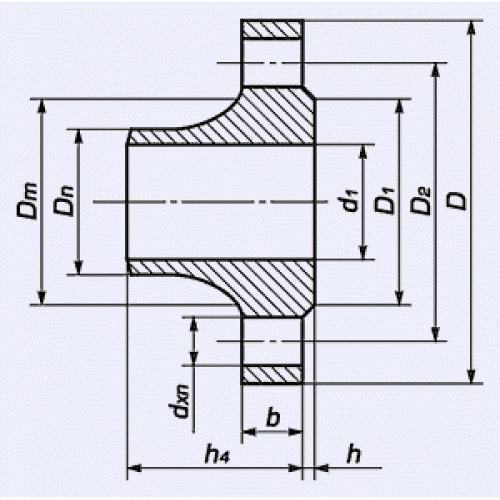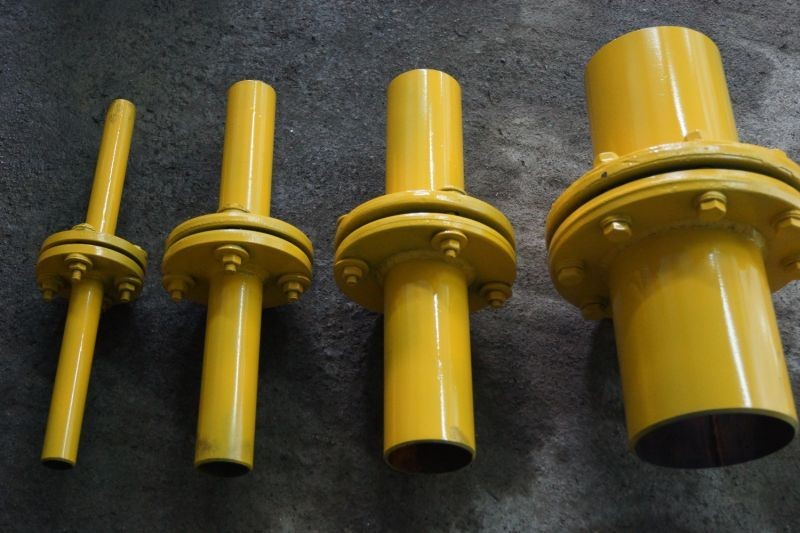Other classification
For some, special types of elements are made. Special flange - what is it? These are the same hardware, but in order to make some work convenient, their design is slightly modified. They can also be welded, loose, cast, threaded. Only grooves are cut out on them or protrusions are welded. For their manufacture, special drawings are first developed and molds are cast. Such hardware is made by order of enterprises.
From afar, huge and long main pipelines (gas, water, oil, steam) seem to be solid and continuous lines. But it is worth coming closer, and the joints of the pipes become noticeable. It is there that the answer to the question of what flanges are is located. They are different: round and square, steel flat welded or steel collar flanges. But all are very important to ensure the safety of pipelines.
Flange manufacturing
Various steel grades are used for manufacturing: 13XFA, 20/09G2S, 12X18H10T, 15X5 M and others. In addition, they can be steel and stainless. The technology used is different. Manufacturers use forging, stamping, casting. For each method, special equipment and molds are used. When releasing their products, manufacturers carefully check their quality. Applying special tests in their work, QCD employees check them for durability and reliability. Flanges are also tested for moisture resistance.
What it is? Since they are fasteners and are involved in connecting metal parts that may come into contact with water, it is important that they are not susceptible to corrosion. That is why waterproof metal alloys are used.
Often manufacturers cover the surface of the flanges with an additional protective layer.
Protrusion Height
If you look at the drawing of a steel flange, then it has several parameters, including the height of the ledge. It is denoted by the letters H and B, it can be measured in all types of products, except for the one that has an overlap connection. The following should be remembered:
- pressure class 150 and 300 models will have a 1.6 mm protrusion height;
- pressure class 400, 600, 900, 1500 and 2000 models have a 6.4 mm protrusion height.

In the first case, suppliers and manufacturers of parts take into account the surface of the protrusion, in the second case, the surface of the protrusion is not included in the specified parameter. Parts brochures may list these figures in inches, where 1.6 mm is 1/16 inch and 6.4 mm is ¼ inch.
Operating pressure
This is the pressure with which a liquid (gas, steam, etc.) is transported through the system. Therefore, the higher the operating pressure in the system, the higher the strength characteristics it is necessary to choose fasteners. In turn, the necessary strength characteristics of fasteners are ensured by the correct choice of material, heat treatment modes, etc. Thus, in the temperature range from -40 to + 400 ° C, and at pressures up to 100 kgf / cm steel 35, while an increase in pressure up to 200 kgf / cm2 requires the use of fasteners made of steel 20X13.
Geometry and specific gravity of products
An important parameter that determines the geometry is the conditional passage of products. As already noted, it is denoted by the letters "DU" and has indicators from 10 to 200. This concerns the choice of the required part: when the user knows Du, all other dimensions are automatically assigned to the flange. For example, for a DN 50 model, the indent height will be 57-59; DN 80 this figure is 89-91, and DN 100 - 108-110, where the first digit indicates the inner diameter of the pipe or pipe, and the second - the outer diameter.

Another important indicator is the weight of the flanges. It depends not only on volumes, dimensions and height, but also on its geometry, material of manufacture. It is worth giving an example: a flange according to GOST 12820-80 with DN 100 of a flat type has a weight of 2.85 kg, while a flange of the same diameter, but of a collar type according to GOST 12821-80 has a weight of 4.4 kg. It follows from this that collar flanges have a greater mass than flat parts.
What are flanges
They are usually used in pairs. Simply put, this is a round or square fastener into which a pipe or other pipeline elements are inserted. The next pipe is inserted into the other flange, after which the two fasteners are bolted together. For this, a large number of holes are provided along the outer perimeter of the part. Other types of products are put on the end of the pipe. The junction of the pipe and the flange is welded. Thus, it is a connecting element of pipelines, tanks, vessels, shafts, devices, etc. For it, you also need to choose the right flange fasteners (bolts, nuts, washers, studs), the type and strength of which directly depend on the same pressure, temperature and type of transported medium.
Insulating flange connections description, purpose of IFS.
An insulating flange connection is a structure often used in pipelines consisting of three flanges, between which a PON-B paronite gasket is used as an insulating seal. The flanges are interconnected by means of studs, which, in turn, are also isolated from the flange by means of PTFE bushings. The design of the insulating flange connection also includes three screws for connecting electrical measuring instruments.
An insulating flange connection is a pipeline element designed to protect the pipeline from stray currents - the so-called electrochemical corrosion. The problem of electrochemical corrosion is acute in the operation of pipelines laid underground. Stray currents, penetrating pipes that do not have reliable insulation, are safe at the inlet, but create a dangerous anode zone at the outlet, in which the metal is gradually destroyed under the influence of electric current. Subsequently, cracks may appear in the system, which can lead to leaks and accidents in the piping system.
In the production of IFS, slates of steel 09g2s, gaskets and bushings made of fluoroplast, hardware from steel 40x (according to GOST 12816) are used.
Cases when the FIS is installed:
• at branches of pipeline sections from the main pipeline;
• near objects that are probable sources of stray currents, such objects can be power substations, tram depots, repair bases;
• when installing a pipeline if its parts are made of different metals;
• to disconnect an insulated pipeline from various potentially dangerous structures or at the entrance to such facilities;
• at the outlet of the pipeline system from the territory of the supplier and at its entrance to the territory of the consumer;
• on vertical above-ground sections of inputs and outputs of gas distribution points and gas distribution stations.
The insulating flange connection is made of two flanges made in accordance with GOST 12820-80 or GOST 12821-80.
In the design, in which flanges are used in accordance with GOST 12820-80, to ensure non-separable installation of connections, steel pipes are welded to the flanges during the installation of connections. This allows you to weld joints without fear of overheating, loss of tightness or loss of electrical insulating properties.
Insulating flange connections on a gas pipeline
Central warehouse store and assembly area
settlement Kryazh, st. Sputnik / st. Kurgan (846) 340-03-41, 330-37-01, 246-53-78
Stroykomplekt LLC is a certified manufacturer of IFS (insulating connection of gas pipelines, insulating flange connection). Certificate of Conformity No. С-RU.АE56.В.00987 TP 0681219 issued by the certification body. Valid from 06/06/2011 to 06/05/2016. .
A special order is possible for the manufacture of components and IFS (insulating flange connection, insulating connection of gas pipelines) with DN up to 300.
IFS (insulating flange connection), insulating connection of gas pipelines) is a firmly tight connection of two pipeline sections, which, by means of an electrically insulating gasket and bushings, prevents the passage of electric current along the pipeline. IFS (insulating flange connection, insulating connection of gas pipelines) consists of three flanges. As a sealant-insulator between them, a paronite gasket PON-B was used. Flange connection is provided by studs, which are isolated from the flange by PTFE bushings. To connect electrical measuring instruments in the design of the IFS (insulating flange connection, insulating connection of gas pipelines), three screws are provided.
Specifications:
Nominal pressure of the medium (Ru) 10, 16, 25 kgf/cm2 Temperature of the medium: from -30 to 250 °С Resistance at a voltage of 1 kV, not less than 5 MΩ
Conforms to GOST 12816-80 Certificate No. ROSS RU.AYu96.V03259 dated 12.04.05 License No. AYu96.V00415 dated 07.05.01
Fig.1 Insulating flange connection
Technical description:
IFS (insulating connection of gas pipelines, insulating flange connection) is a firmly tight connection of two sections of the pipeline, which, by means of an electrically insulating gasket and bushings, prevents the passage of electric current along the pipeline. The design of the IFS (insulating connection of gas pipelines, insulating flange connection) is shown in fig. IFS (insulating connection of gas pipelines, insulating flange connection) consists of three flanges (pos. 1 and 3). As a seal between them, a paronite gasket PON-B (pos.5) is used. The connection of the flanges (pos. 1 and 3) is provided with a pin (pos. 4), which is isolated from the flange (pos. 1) by a fluoroplastic bushing (pos. 2). To connect electrical measuring instruments in the design of the IFS (insulating connection of gas pipelines, insulating flange connection), three screws (pos. 6) are provided.
Flange pressure classes
Parts manufactured according to Asme (Asni) standards are always characterized by a number of parameters. One of these parameters is the nominal pressure. In this case, the diameter of the product must correspond to its pressure according to the established samples. The nominal diameter is indicated by a combination of the letters "DU" or "DN", followed by a number characterizing the diameter itself. Nominal pressure is measured in "RU" or "PN".

The pressure classes of the American system correspond to the conversion to MPa:
- 150 psi - 1.03 MPa;
- 300 psi - 2.07 MPa;
- 400 psi - 2.76 MPa;
- 600 psi - 4.14 MPa;
- 900 psi - 6.21 MPa;
- 1500 psi - 10.34 MPa;
- 2000 psi - 13.79 MPa;
- 3000 psi - 20.68 MPa.
Translated from MPa, each class will indicate the flange pressure in kgf / cm². The pressure class determines where the selected part will be used.
Flange varieties
On the official website of our company, a virtual catalog is presented, in which all sold fittings are placed by thematic sections. In it, a separate place is allocated to flanges, which differ from each other not only in modification, but also in the following parameters:
- according to the method of installation;
- by scope;
- according to the materials that were used in their manufacture;
- according to operating parameters.
Today, flat and collar flanges are available for our company's customers. They are actively used by business entities specializing in the production and extraction of minerals.
Collar flange features
In the process of manufacturing collar flanges, manufacturers use high-strength steel of various markings as the main raw material. Finished products are able to withstand a pressure of 1-10 MPa and can be operated at various operating temperatures, therefore they are classified as follows:
- steel grade No. 20 and 25 - the flange will perform the functions assigned to it at temperatures up to - 30 degrees;
- structural steel grades - flanges can be operated at extremely low temperatures up to -70 degrees.
The design features of collar flanges include the presence of truncated protrusions on their surface. The functions of this element are to ensure a tight connection of pipes.
Technical features of flat flanges
Flat flanges are manufactured in a production environment that uses high-tech equipment and modern technical standards. Finished products fully comply with state norms and standards, and are supplied for sale along with accompanying documentation and relevant certificates. The main purpose of flat flanges is to provide detachable pipe connections, during the installation of pipelines and control units for valves and systems. At the same time, it should be noted that, despite the possibility of quick dismantling of such flanges, their use guarantees the most hermetic connection for engineering communications. These fittings are able to perform their functions for many decades at a wide temperature range: from + 300 to - 70 degrees. Visitors to the website of the TK Engineering company have access to various modifications of flat flanges made of steel, which are made of the following types:
- heat resistant;
- stainless;
- alloyed, etc.
We also offer:
Flat flangesSteel flat welded flanges
What are they made of
Flanges are made of steel. Depending on the working pressure, temperature and type of medium (steam, gas, oil, water), they are produced either from a special alloyed or from ordinary grades of carbon and stainless steel.
Main types:
- the most common are conventional flat welded flanges;
- steel collar flanges are more durable and comfortable;
- for installation in hard-to-reach places, a free flange on the welded ring is most often used;
- non-standard flanges, which are made according to individual drawings for a specific order.
Consider the most popular product options.
Types of flanges
So, the flange is, first of all, hardware. Depending on the application, these parts can be flat, collar, free. The design is not much different. On the collar flanges there is a small protrusion resembling a cone. It is often referred to as a collar. This type of flange is used when it is necessary to weld parts end-to-end. This protrusion helps to tightly connect the connecting parts of the pipelines. They are also necessary when pipelines are connected to tanks or other technical equipment. The main advantage of such flanges is that they can be used several times. These hardware are made of durable materials, and this allows them to be used in work where the temperature ranges from -253 to +600 degrees Celsius.
Flat flange - what is it? This is a hardware that resembles a flat disk with holes. It is used when it is necessary to connect parts of fittings, shafts, vessels, pipelines, devices and the like. With this element, parts of pipelines can be tightly fixed.
Loose flange - what is it? This species is not much different from the above. It consists of two parts: a conventional flange and a ring
It is important that they are made of the same material and have the same diameter and pressure. They are used where the work is most difficult, where it is difficult to perform installation.
Due to the two parts, the connection will be tight and durable. First, a conventional flange is connected (it is welded), and the other ring can then be safely rotated during operation.
How a flange connection is made
When it is necessary to connect two parts of the pipeline, welding of a steel flange to the pipe is used. This fixation is called a flange connection and in the future makes it possible to disassemble the pipeline in order to carry out repairs. To understand how the assembly takes place, it is necessary to consider the process in detail:
- To join two elements, flat parts are used that have a hole in the center where the end of the pipe is inserted.
- Holes are placed along the perimeter of the ring - fasteners are inserted into them: bolts or studs with nuts.
- The connection will be detachable so that it is airtight using gaskets. A flange connection is designed to join two pipes or connect a pipe to a tank equipped with a flanged inlet pipe.
 An illustrative example of a flange connection
An illustrative example of a flange connection
You can make a flange with your own hands - such a detail is perfect for a sharpener for a machine for sharpening objects.
Joint production tools
To independently connect two pipe parts, you need to prepare tools. Basically, this is equipment designed for tightening bolted connections around the circumference of the flanges:
- manual key;
- cap key;
- pneumatic impact wrench;
- hydraulic torque wrench;
- hydraulic type bolt tensioner.
 Docking on pipes
Docking on pipes
In addition, a special lubricant is required, which is applied to both surfaces to avoid friction of parts and ensure ease of torque. The sequence of work is simple: first, they tighten the first bolt, then proceed to twisting the one that is 180 degrees diagonally from the first. Next, they move on to the bolt located at an angle of 90 degrees from the second, and from it to the opposite.
Tips from the masters
There are a number of useful recommendations from professional craftsmen that will help you deal with a flange connection the first time:
- If the parts have 4 holes, then tighten the bolts crosswise.
- The surface of the structure must be degreased and checked for corrosion and rust.
- It is recommended to use only new gaskets, and they must be installed strictly in the center.
- The tightening force of the bolts must be uniform - this is the only way to ensure a reliable and tight flange connection.

In order to remove the flange in the future, special machines are used to help bore it and open the bolts. It is difficult to remove the parts manually, so pneumatic tools are used.
Connecting pipes with flanges is a convenient and reliable type of joining of two parts. It helps in the future to repair the pipeline by removing the connecting elements, while welding will not allow this procedure to be carried out. It is selected in strict accordance with the working conditions, temperature and pipe diameter.
What is the part made from?
In industry, steel flanges are used, but the steel from which the part is made also varies. The marking of steel flanges will determine in what conditions it is better to use this part:
- Steel 20 is the most used raw material. This is carbon steel, parts from it are used to assemble fittings on highways, where the external temperature is not lower than -40 degrees, and the internal indicators are not higher than +475 degrees.
- Steel 09g2s - steel from alloys of nickel, chromium and molybdenum, designed for welding. Products from this material can be operated at an external temperature of -70 degrees.
- 12X18H10T - cryogenic steel. Parts made of this material can be used in aggressive environments, such as alkalis and acids. Permissible temperature from -196 degrees to +350 degrees.
- 10X17H13M2T - corrosion-resistant ordinary steel. Fasteners from it are operated in especially extreme conditions, because it remains resistant to corrosion under stress. Operating temperatures from -196 to +600 degrees.
- 15X5M - low-alloy heat-resistant steel. Such products have a high resistance to oxidation at rates of + 600-650 degrees.
These brands are the most used, but in addition to them, manufacturers use other raw materials. There are polypropylene models - they are designed for joining polypropylene pipes with metal valves. The operating temperature of such material is much lower - +80 degrees. They can be supplied with a collar for a flange - a special part for creating a flange connection made of polypropylene.

In addition to steel and propylene, two types of cast iron are used - malleable and gray. Ductile iron parts are used at operating temperatures from -30 to +400 degrees, and gray cast iron parts are used at temperatures from -15 to +300 degrees.
Insulating flange connections
Thus, it simultaneously does not absorb moisture and avoids the passage of electric current through the pipeline. Sometimes gaskets are also made from PTFE or vinyl plastic. The IFS also contains tightening studs, polyamide bushings, washers and nuts. Thanks to these hardware, the flanges are pulled together and fixed in this position. Order the manufacture of flanges only from us.
In general, insulating flange connections are a strong connection between two pipeline elements. An important role in it is played by an electrically insulating gasket, which makes it possible to exclude the ingress of electric current into the pipeline. On average, the resistance of one insulating flange connection is at least 1000 ohms.
Insulating flange connections
IFS is a composite structure produced in the conditions of the enterprise, which has the necessary tightness and isolation. Its main function is to cathodically protect underground and above-ground pipes and thus extend their service life.
Installation process
- The installation of the IFS is carried out at the place where the pipes come out of the ground and at the entrance to it. The need for its installation is due to the likelihood of the pipe coming into contact with electrical contacts, grounding and other communications. Including at the outlets of pipelines of GDS, GRU, GRP.
- The installation of the IFS is immediately included in the project during its preparation and is carried out by special installation teams.
Our company is ready to produce these designs of any diameter specified by the customer. Production is carried out on the basis of GOST. For example, we offer products from high-carbon brand 09g2s with steel hardware 40x., Fluoroplastic bushings.
We keep all guests
Insulating connections
Insulating flanges are not recommended to be installed on those gas pipelines that are located in explosive areas. Including gas distribution stations, in places where gas is cleaned and odorized.
IFS are designed to block the ingress of stray electric current into the pipeline. To do this, the flange connection, assembled at the enterprise, is equipped with insulating gaskets made of dielectrics (textolite, paronite, klinergit, etc.). Insulating materials are placed not only between the flanges, hardware is also made from special materials:
In other words, FSIs are used to create electrical sectioning of parts that are located underground and above it. The safety of the gas pipeline depends on the form in which the flanges will be contained.
In the manufacture of insulating flange connections and installation in hazardous places (with compressor stations, tanks, etc.), where the magnitude of the current in the pipelines can be high, it is necessary to regularly check and prevent the working condition of the IFS. For this, the insulating flanges must be located in specially created working wells.
Such structures must necessarily be equipped with control conductors that go outside. This is necessary so that service workers can carry out the necessary electrical measurements without descending into the well.
IFS are not only used as protective structures on pipelines from the corrosive effects of electric current, they are also installed when gas and oil products approach pumping stations and other structures.


